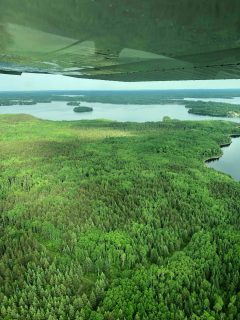 Journal Entry #3: Enriching Explorations
Journal Entry #3: Enriching Explorations
June 9, 2018
By Abbey Morris
On June 1st, we drove 230 km from Sioux Lookout to Mishkeegogamang First Nation to have a meeting to discuss the Indigenous Youth Futures Partnership with some of the community members. On the way there, I saw 4 bears, burnt forests and lots of fallen trees. The road was winding and had lots of hills, but the drive was very pretty. I sat in the back and enjoyed the view. We arrived early, so we did a little tour of the town. There was one community centre, the band council office, and a few clusters of houses, but everything was very spread out. The meeting started late, and some people didn’t show up. The meeting environment was very different than the fast-paced lifestyle found in the big city. At the end of our visit, we went to the gas station to fill up the car. The gas station was sparse with a single gas tank sitting above the ground and a small trailer sized building that served as the convenience store. There were not many other cars around and we saw a few hitchhikers along the side of the road. People walk for miles to get from one end of town to the other. There did not seem to be much to do in Mishkeegogamang so I do not know if I would be able to live there. The lack of activity and stimulation would be difficult. The main concerns that the community members expressed revolved around transportation and activities for youth.
After our trip to Mishkeegogamang, we started doing interviews with hospital staff and I have learned more about the services offered for new mothers in Sioux Lookout. The doctors and nurses that we talked with highlighted the Mental Health and Addiction Program and Integrated Pregnancy Program, as well as the social worker that they have at the hospital. The social worker helps with practical and logistical issues such as getting babies registered and applying for social assistance. It was brought up that many women do not show up for their appointments, perhaps due to higher priorities such as grocery shopping or shopping for baby supplies which they do in town because the options are limited and prices are much higher in their home communities. It was also interesting to see the difference between interviewing staff versus mothers. The staff have more to say since they are aware of most of the services available to women.
 The mothers do not talk as much and appear to be very shy. Also, there seems to be a lack of knowledge about traditional practices. One woman mentioned that in some communities the church has had a large impact on the perception of traditional practices serving as a disincentive to participate. This is unfortunate because the ceremonies and cultural activities can be quite beautiful and have been shown to have healing powers.
The mothers do not talk as much and appear to be very shy. Also, there seems to be a lack of knowledge about traditional practices. One woman mentioned that in some communities the church has had a large impact on the perception of traditional practices serving as a disincentive to participate. This is unfortunate because the ceremonies and cultural activities can be quite beautiful and have been shown to have healing powers.
The beauty of Indigenous culture is portrayed throughout the hospital’s architecture. From the ceiling in the waiting room that looks like the inside of a canoe, to the hostel with its drum shaped roof, and the tranquil Healing Room that displays many cultural symbols such as eagle feathers, the 4 stages of life, and the medicine wheel, it was all very different than what you would find in a Southern Ontario hospital. When interviewing one of the traditional healers at the hospital, we learned that the colours and positioning of each section of the medicine wheel changes depending on which clan a person comes from and what they believe. The Meno Ya Win Health Centre is tailored to not only welcome First Nations people, but it also embraces their traditions.
 In addition, the beauty of the land was on display when my mom came to visit and we embarked on a floatplane sightseeing tour. Taking in the natural beauty of the lush green forests and vast lakes that surround Sioux Lookout allowed me to view the town from a new perspective, helping me to appreciate just how much Mother Earth provides for us and our wellbeing.
In addition, the beauty of the land was on display when my mom came to visit and we embarked on a floatplane sightseeing tour. Taking in the natural beauty of the lush green forests and vast lakes that surround Sioux Lookout allowed me to view the town from a new perspective, helping me to appreciate just how much Mother Earth provides for us and our wellbeing.